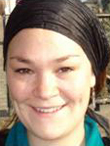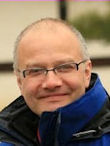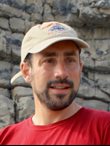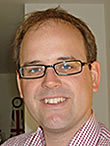 Dr Rebecca Bartlett
Dr Rebecca Bartlett
Rebecca is a biogeochemist, specialising in nutrient cycling and environmental change in modern and past environments. Her research focuses on the biogeochemistry of peats, soils and sediments during environmental disturbance; the subsurface microbial response to natural and anthropogenic changes in atmospheric sulphur deposition, temperature, storms and floods, mineral reactivity and chemical pollution. Using a combined field and laboratory approach, and stable isotopic techniques, Rebecca’s work examines the small-scale (local) consequences of long-term (global) changes to the environment, and subsequent impacts on pH, carbon dynamics, major nutrient cycles and water quality.
 Dr Ian Boomer
Dr Ian Boomer
Ian is a micropalaeontologist who studies calcareous benthic microfossils, particularly ostracods (microscopic Crustacea), but also foraminifera, to reconstruct past environments. His work spans much of the last 200 million years of earth history, with projects as diverse as the late-glacial history of lakes in Scotland to Mesozoic Ocean Anoxic Events.
 Dr Tom Dunkley Jones
Dr Tom Dunkley Jones
Tom is a micropalaeontologist and palaeoceanographer specialising in the study of fossil coccolithophore algae. Recent PhD students have developed new SIMS-based techniques for the determination of single coccolith Sr/Ca ratios (Prentice et al. 2014) and the application of the Sr/Ca proxy to understand algae growth rates across key events in the Cenozoic climate record. With students and post-doctoral fellows, he is currently working on Sr/Ca records through the Eocene/Oligocene transition (IODP Exp. 320) and the late Pliocene (IODP Exp. 363).
 Dr Kirsty Edgar
Dr Kirsty Edgar
Kirsty is a micropalaeontologist and palaeoceanographer, specialising in planktic foraminifer and foraminifer-based geochemical records. She is interested in understanding the timing and nature of the interaction between global climate, geochemical cycling and the marine plankton.
 Professor Ian Fairchild
Professor Ian Fairchild
Ian Fairchild is a geoscientist with broad interests in the geochemistry of the Earth’s surface, climate change and Quaternary and Neoproterozoic earth history. He employs this breadth of knowledge in teaching, in public outreach, and professional activities such as examining and research assessment. He is equally at home in the field and the laboratory with a wealth of experience in glacial environments, caves, rock successions and at national and international geochemical research facilities. Ian chairs NERC's Isotope Geosciences Facility Steering Committee and is a member of the Anthropocene Working Group, and the Cryogenian Commission group of the International Commission on Stratigraphy. He is an Emeritus Professor at Birmingham.
 Dr Sarah Greene
Dr Sarah Greene
Sarah is a palaeoclimatologist, geobiologist, and numerical modeller studying the biogeochemical cycling of carbon between the atmosphere, the ocean, and marine sediments. Particular research interests include mass extinctions and other rapid carbon cycle perturbations, multi-mullion year carbon cycle trends (co-evolution of life and the carbon cycle), and how biogeochemical cycling within marine sediments influences the rock record. Sarah also studies microbially-mediated carbonate rocks, such as stromatolites, to gain insight into past climates and environments.
Dr Matt O’Callaghan
Matt’s is an entomologist interested in the impacts of changing climate on ecosystem functioning. He uses mass spectrometry methodologies to investigate resource selection and transfer processes across terrestrial and aquatic ecotones. As Experimental Officer, he is responsible for the management and day to day running of the GEMS facility. Prior to this role, he was Senior Lecturer (Ecology) at the University of South Wales and Research Fellow at the University of Birmingham (NERC –DriStream).
 Dr Ivan Sansom
Dr Ivan Sansom
Ivan specialises in the evolution and diversification of Palaeozoic non-tetrapod vertebrates, including conodonts, with a particular focus on the earliest skeletonising fish and the origin of the sharks. Current research primarily focuses on patterns of dispersal within early vertebrates and the influence of their palaeoecology on diversity and extinction.
 Dr James Wheeley
Dr James Wheeley
James' research focuses on utilising conodont oxygen isotopes to elucidate conodont palaeoecology and seawater temperature changes, particularly for the Ordovician. Recent work has been on material from Anticosti and Newfoundland, Canada. Limestone samples collected from Anticosti have also been analysed for uranium isotopes; these tell us about global ocean redox conditions during the end Ordovician mass extinction.